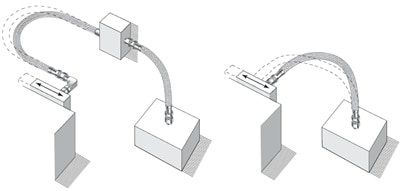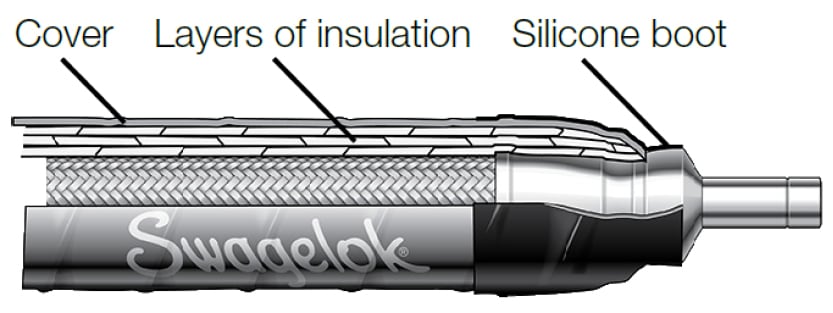Proper Hose Selection: Things to Consider When Choosing a Hose for Your Application

Things to Consider When Choosing a Hose for Your Application
On the surface, hoses look and seem simple. They tend to be overlooked, often not a focal point amidst other engineered components for a given application. Perhaps that also partially explains why hoses are also then on the receiving end of abuse and mistreatment in the field. All of this is really kind of too bad because hoses actually represent a very technical network of complementary elements that come together to do what piping or tubing normally achieve, only hoses – very simply – must also fulfill the role of a “flexible connection” on a P&ID. This very basic and obvious feature is easily taken for granted, and to select the proper hose for an application, one must dive into not only material compatibility but hose strength, flexibility, insulation, and permeation just to list a few. If any of these factors relative to the application are misunderstood during specification, the hose’s service life can be dramatically impacted, and that creates not only more maintenance but higher risk of safety issues.
Materials
Most hoses fall into one of five hose families: Metal, Hybrid, Fluoropolymer, Thermoplastic, and Rubber. Each type of hose certainly has its limitations, but where do you start? A quick way to narrow down the type of hose for a specific application is to crosscheck the design pressure and temperature of the application against different hose types.
Metal hose is made from a very thin corrugated tube, which gives the hose its flexibility and higher pressure ratings but can lead to early fatigue failure in dynamic applications in which the hose is subjected to constant movement. For this reason, you tend to see metal hoses in static, high pressure/temperature applications where permeation must be minimized.
Fluoropolymer hoses (PTFE) are often used in applications where chemical compatibility is a challenge or the hose core/lining needs to be smooth and not corrugated like a metal hose. These PTFE hoses are often very flexible and clean but do suffer from permeation in gas applications, particularly ones with small molecules such as hydrogen and helium. Gas molecules – driven by the relative difference in partial pressure between hose core and the environment, will actually migrate into the lattice structure of the fluoropolymer and eventually leak out.
Rubber and thermoplastic hoses are also smooth core hoses often selected for specific applications such as hydraulic (thermoplastic) and cheap, less critical applications (rubber). Each core material has strengths and weaknesses. As mentioned, permeation affects all hoses, but some types are better suited to prevent substantial amounts of permeation.
In critical applications where process media must not permeate through the hose, it is best to consider an all metal core hose. While technically, all materials are subject to permeation, the rates through metal are too low even to measure. In PTFE core hoses, one could expect upwards of 150 cc/foot/hour through a ¼” non-sintered hose with 3,000 psig nitrogen. For those applications where a PTFE core would be beneficial, but permeation is a concern, consider cores that are either slow-sintered or post-sintered in which the material is heated for a period of time to reduce its porosity. Both significantly reduce the permeation rate. A slow-sintered core would permeate 20 cc/ ft/hour under the same conditions as above, and the post-sintered core would only permeate 4 cc/ foot/hour – an improvement of almost 40x!
Static Dissipation
Another critical aspect most do not consider when selecting a hose is how the hose handles static dissipation within the core. As gases or liquids flow through the hose, the friction causes a build-up of electrons on the inner core wall. In non-conductive materials (PTFE, Rubber, Thermoplastic), this charge continues to build until the charge jumps from the inner wall to the outer metal braid of the hose. During this static discharge, a pinhole is formed in the core tube resulting in small leaks. When specifying a hose in an application where static dissipation is a concern, make sure to specify either a metal core or a PTFE with carbon-infused core. This infused core allows the static charge to travel slowly and in a controlled manner along with the core and into the end connections preventing any potentially damaging discharges through the core to the outer braid.
Flexibility

Of all the issues discussed, dynamically bending in multiple planes tears apart a hose the fastest. Imagine a hose with one vertical connection and one horizontal connection, but they are offset from each other. This hose is considered to be bent in two planes.
Although a static hose bent in multiple planes could live a long and healthy life, if one of these connections is dynamic, the hose fails very quickly. The dynamic motion causes a twisting motion in the hose, which will either twist the barbs in the end connection or twist the core material of the hose. Either of these results will accelerate hose failure.
Bulk hose is produced in long lengths and spooled. Storing the bulk hose on a spool gives the hose a ‘natural’ radius and one should make every attempt to avoid bending the hose in the opposite direction. This will make installation go a little smoother and likely prolong the life of the hose.
Insulation
Just by the nature of where hoses are typically located in the field, they may present a severe human safety risk for burns in a hot service. Similar to any other pipe or tube, a hose can be insulated. This insulation not only protects operators from burns but can also insulate the process resulting in lower heat losses.
Insulation offers some overall protective covering for the outer hose braid as well, but a thermosleeve or spiral guard offers another way to shield a hose from abrasion issues as it moves and comes into potential contact with other surfaces where insulation is not required. Separately, an armor guard can help protect the hose from being over bent or kinked.
With some additional care and attention paid to some of these details, we can hopefully see lower maintenance costs and higher overall levels of safety in the field.




